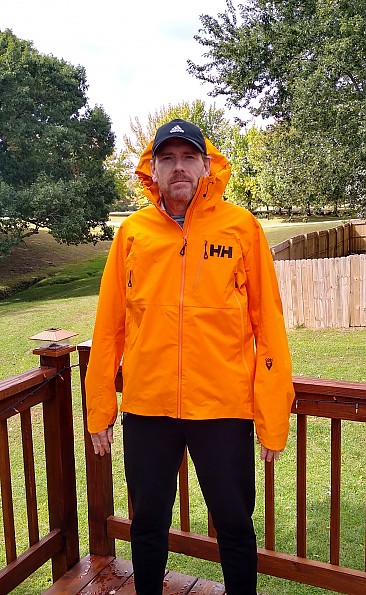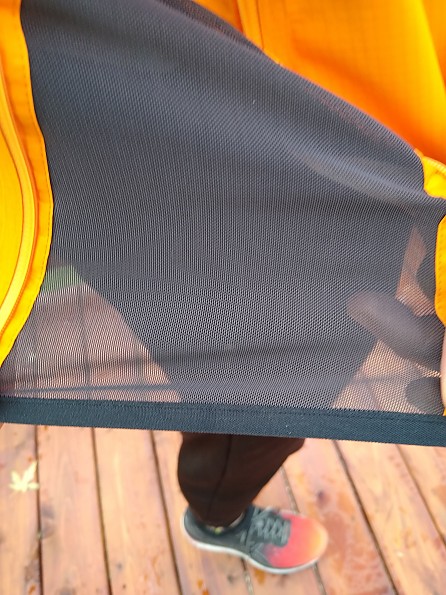Helly Hansen Odin 3D Air Shell Jacket

Helly Hansen’s Odin 3D Air Shell raises the bar for competitors claiming their rain shells are both waterproof and breathable. Minimizing the feeling of plastic against your skin, the jacket is amazingly comfortable and decently lightweight. This jacket is truly the most breathable rain shell I have ever worn hiking and camping. A significant con is the inability to cinch up the sleeves at the wrist to keep water out though.
Pros
- Waterproof - 5 stars
- Windproof - 5 stars
- Breathable - 5 stars
- Comfortable - 5+ stars
- Packable - 4 stars
- Lightweight (12 oz) - 4 stars
Cons
- Accessibility of pockets - 1 star
- Pocket placement - 1 star
- Sleeves do not cinch at wrist - 0 stars

When sitting down to write up my own review, I read a number of reviews by folks that made me question whether or not they had actually worn the jacket in heavy rains. The pictures I took in the rain turned out blurry and useless. So you will find my pics in this review are on a clear day on my back deck. But below is real world footage from tests in the jacket during some intense thunderstorms.
Size & Fit
The jacket runs true to size, but you probably want to go up a size for layering. Helly Hansen has a helpful sizing chart on each product's page that asks more than just the standard height/weight questions (men's and women's). I'm a medium build, and the suggested size large is perfect for layering over cold weather clothing.
The torso is nice and long, coming down below the hips (and, therefore, below a backpack belt). Added length in the back keeps your bottom dry if you’re not wearing rain pants.



The length on the sleeves is perfect for my monkey arms. The hood is roomy enough for a climbing or bike helmet, but will cinch down comfortably when not wearing one. A slightly stiffer “brim” on the hood holds it far enough off the forehead to keep rain from dripping onto your face.


Waterproof, Windproof, AND Breathable? YES!
I have always been a skeptic of this golden triad of claims. Adding a few zippers and vents to a "plastic" jacket only helps if you can use the vents—not an option in heavy rains. So I was not expecting the Air Shell to be much different.
I was wrong. HH uses 3D printing technology to keep the bulk of the fabric off the skin. This pocketed backing allows air to move inside the jacket, even when zipped up in heavy winds and rains. The material actually touching your skin has a soft, silky feel to it.

In the video testing, the shell stood the test in heavy rain and wind. My first video shoot in the jacket was during a full hour of unrelenting downpour. The second video test was forty-five minutes of pounding rain in high winds. In both tests, my rain pants soaked through, but the Odin Shell remained water tight.

Carlinville, at the right edge of the storm coming in on my second test.
Both video tests also occurred with humid, 80-degree temperatures. Yet even with the vents zipped up, I did not feel especially clammy. Nor was there a wet-nylon/plastic feel you normally get after a typical rain jacket has been thoroughly wetted. This shell is comfortable.
Non-video testing involved hiking with a backpack in much milder conditions, with on and off light rains.
Venting
Venting is where you would expect in the back of the jacket (high and between the shoulder blades).


However, the side vents are not the traditional “pit zips” that my other rain jackets have. As I mentioned, I was comfortable in the jacket, even with the vents fully closed. So I don’t know if moving the vents away from the armpits is really an issue. A heavy sweating person might find this to be a con, but I was fine.


Out of the box, I thought the placement of the side vents would be hampered by a backpack belt. I envisioned having to unclip my belt every time I wanted to open the vents. I was wrong. The generous length of the jacket, combined with both top and bottom zippers, allowed me to open and close the shell without any problems.

The side vents are lined with mosquito mesh, and when fully unzipped, the structural integrity of the jacket is held by the mesh and a piece of elastic webbing.

Weight and Packability
At 12 ounces, the shell is a good weight for its level of performance. The shell packs down to the size of a Nalgene bottle and stuffs into its own chest pocket. Though it’s worth noting it takes a bit of work to get the jacket into the pocket—it’s a snug fit. [Note: The manufacturer states the women's version of the jacket zips into an internal pocket and turns into a sling pack.]

This Thing Has Pockets??? (Not great ones)
My original "cons" list was the jacket having only one chest pocket (discussed further down). To my chagrin, as I was photographing pics of the side vents, I discovered nice, roomy pockets inside the vent zippers (pic below). I consider this a con, in that one must unzip/open a significant portion of the vent in order to reach the pocket. It also means that if the vents are open, items inside the pockets remain exposed to the elements and the watertight pockets can pool with water. Additionally, with the vents open, there is nothing preventing items from falling out.

Another con to placement is that the pockets run directly under the hip belt of a pack. So they are both inaccessible while wearing a pack and with limited use, as some items in the pocket would be between the hip belt and the wearer. In short, you're not going to put your bag of trail mix in here for snacking.

After posting my original draft review, the staff at Trailspace reached out to Helly Hansen for comment. Their response:
The jacket was designed to be really lightweight, with lots of venting. Designed for more fast and light kind of pursuits so we eliminated things like the cuff Velcro tabs to make it lighter and simpler.
With the vents/pockets, venting is the main priority for this jacket. The pockets are not meant to be secure pockets as they don’t have zips, which is why we have the zippered chest pocket. Again, trying to keep this light and simple. Much like the minimalist (jacket), the secure pocket is the chest pocket. The hand pockets are more for...hands.
The chest pocket is roomy enough for a cell phone. But again, the pocket runs under the chest strap. So it’s not a place I want to store anything while backpacking.


Other Features
You will find cinches for the waist inside the bottom of the jacket and on the back of the hood. As I mentioned in the video (time stamp 1:46), I was skeptical of the cord lock on the front of the hood, but they worked perfectly in some extremely high winds.


The Sleeves! Oh, those awful sleeves!
Even with the pockets, I would still rate this a 5-star jacket—until we start talking about the sleeves. There is nothing to cinch the opening of the sleeves down to keep the rain out. Your only option is to walk with your hands straight down at your sides.

Put simply, these sleeves HAVE to be fixed.
When I filmed that segment in July, I was wearing a short-sleeved shirt and considered the wetting of my forearms to be a minor inconvenience. But here in mid-October, I’m starting to wear base layers. Soaking wet sleeves could make for either a miserable night’s sleep or ice-encrusted sleeves when you try to put your wet base layer on the next morning. My other rain shells all offer a velcro strap to allow the sleeves to be sealed up. The absence of this is a big con. On a $350 shell—it’s nearly a deal breaker.
Referring back to Helly Hansen's response to Trailspace staff:
The jacket was designed to be really lightweight, with lots of venting. Designed for more fast and light kind of pursuits so we eliminated things like the cuff Velcro tabs to make it lighter and simpler.
To me, this is an insufficient response. Without the closures, the wearer is not fully protected. Velcro tabs would only add a few grams of weight to the jacket and would be no more complicated than the cinch on the hood. It reminds me of the saying, "There's 'ultralight,' and then there's 'stupid light.'" What's the point of shaving a few grams if it means being wet and cold in the forearms?
Summary
I hate to leave this review on a negative note. The comfort of this jacket is ridiculously nice, and I’ve never worn a rain shell so breathable. If you don’t use trekking poles, you might not care about cinching the sleeves. Or you can run down to a fabric store and come up with a DIY option. I’m hoping Helly Hansen will recognize the need to correct this and keep rolling out this otherwise great product.
Background
I hiked in as many rain events as I could in June and July before the summer drought set in. This meant running out the door for day hikes of 1-2 hours whenever bad weather moved in—weather that I would normally stay in for. (I drowned my cell phone in one of the video attempts and had to put it in rice.) Late-July through September were painfully dry this year. October has allowed for one multi-day backpacking trip with light rain.
Source: received for testing via the Trailspace Review Corps
(Sample for testing and review provided by Helly Hansen)
I agree with your review and a pity I didn´t read it before buying it. Great jacket but the loose sleeves are a huge flaw that leaves you exposed to water (HH answer is simply unacceptable).
Cons
- Loose sleeves
- Inside pockets
Good jacket with a big con.
Source: bought it new
Price Paid: 245€
Your Review
Where to Buy
You May Like
Specs
| Men's | |
|---|---|
| Price |
MSRP: $350.00 Historic Range: $171.00-$284.99 |
| Weight |
376 g |
| Women's | |
|---|---|
| Price |
MSRP: $350.00 Historic Range: $94.73-$349.95 |
| Weight |
324 g |


